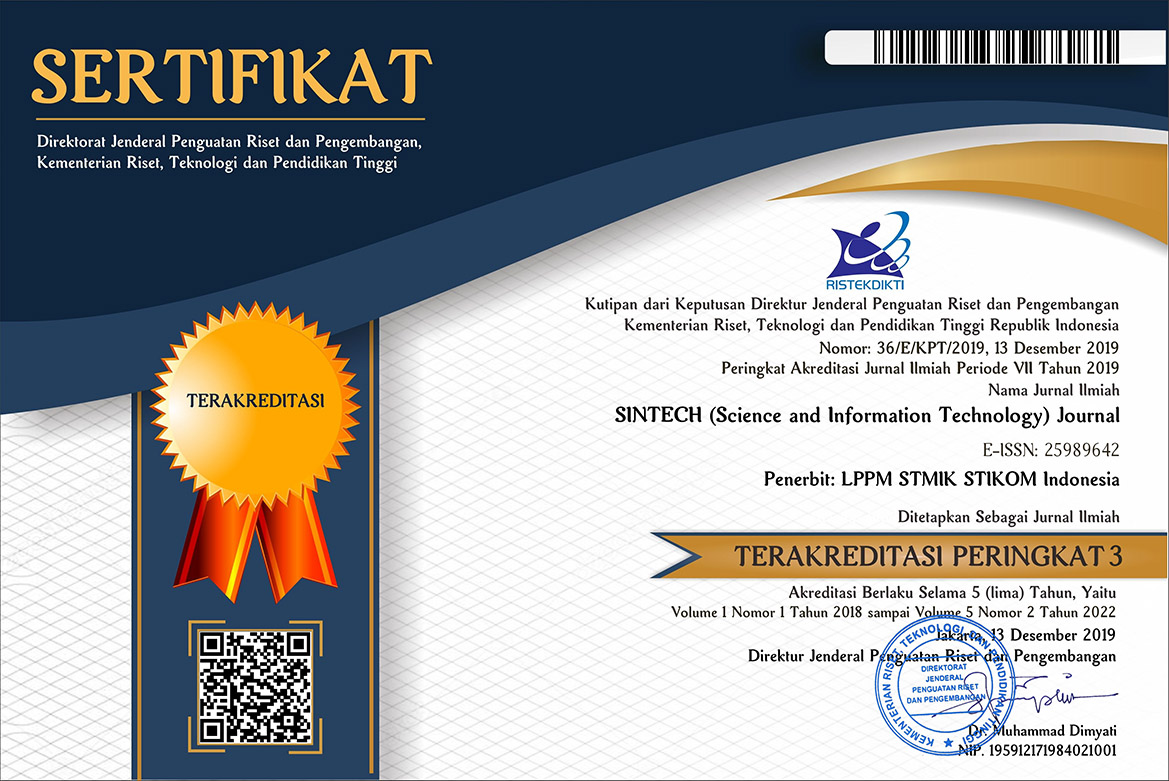Analisis Penerapan Metode Association Rule Mining Untuk Transaksi Penjualan di Toko Bangunan Dengan Algoritma Apriori
DOI:
https://doi.org/10.31598/sintechjournal.v5i2.1193Keywords:
transaction data, association rule, apriori algorithm, data miningAbstract
In improving the quality of service to customers, UD. Lasmi Jaya store is asked to be able to handle problems that often arise, among others, lack or absence of (out of stock) stock of building goods that are very popular, less strategic layouts, assist in decision making to develop marketing strategies and promote better products and more. Therefore, in this problem, there must be utilization of sales transaction data for processing using a priori algorithms so that it can provide new knowledge that can be utilized by shop owners. From the results of research that has been carried out from 300 sales transaction data from January 1, 2022 - June 30, 2022 with a comparison of a minimum transaction of 15 or a minimum of 5% support and a minimum of 40% confidence with a minimum of 12 transactions or a minimum of 4% support and a minimum of 30% confidence, associations the final results found were more at least 12 transactions or minimum support 4% and minimum confidence 30% because if the minimum support value and minimum confidence value were lower then the association value found would be more, so for determining stock of goods or layout of goods or as promotion and others so that it will make it easier for the owner to manage their sales so that they can grow and provide satisfaction
Downloads
References
A. M. Tida and A. Zubair, “Analisa Transaksi Penjualan Menggunakan Metode Algoritma Apriori (Studi Kasus Toko Busana Sakato, Gajah Mada Plaza B-19 …,” J. Tek. Inform. Kaputama …, vol. 6, no. 1, 2022.
J. Han and M. Kamber, Data Mining: Concepts and Techniques. 2006.
Y. Wahyuningtias and R. Rusdiansyah, “Analisis Penerapan Asosiasi Untuk Menentukan Transaksi Penjualan Pada What’S Up Café Dengan Metode Algoritma Apriori,” J. Ris. Inform., vol. 1, no. 4, pp. 181–186, 2019.
A. Oktaviani, G. TM Napitupul, D. Sarkawi, and I. Yulianti, “Penerapan Data Mining Terhadap Penjualan Pipa Pada Cv. Gaskindo Sentosa Menggunakan Metode Algoritma Apriori,” J. Ris. Inform., vol. 1, no. 4, pp. 167–172, 2019.
N. Agustiani, D. Suhendro, W. Saputra, and S. Tunas Bangsa Pematangsiantar, “Penerapan Data Mining Metode Apriori Dalam Implementasi Penjualan Di Alfamart,” Pros. Semin. Nas. Ris. Dan Inf. Sci., vol. 2, pp. 300–304, 2020.
A. Prasetyo, R. Sastra, and N. Musyaffa, “Implementasi Data Mining Untuk Analisis Data Penjualan Dengan Menggunakan Algoritma Apriori (Studi Kasus Dapoerin’S),” J. Khatulistiwa Inform., vol. 8, no. 2, 2020.
F. A. K. Wardani and T. Kristiana, “Implementasi Data Mining Penjualan Produk Kosmetik Pada PT. Natural Nusantara Menggunakan Algoritma Apriori,” Paradig. - J. Komput. dan Inform., vol. 22, no. 1, pp. 85–90, 2020.
I. Zulfa, R. Rayuwati, and K. Koko, “Implementasi data mining untuk menentukan strategi penjualan buku bekas dengan pola pembelian konsumen menggunakan metode apriori,” Tek. J. Sains dan Teknol., vol. 16, no. 1, p. 69, 2020.
A. Novianti and E. Elisa, “Penentuan Aturan Asosiasi Pola Pembelian Pada Minimarket Dengan Algoritma Apriori,” Build. Informatics, Technol. Sci., vol. 2, no. 1, pp. 64–70, 2020.
D. Anggraini, S. A. Putri, and L. A. Utami, “Implementasi Algoritma Apriori Dalam Menentukan Penjualan Mobil Yang Paling Diminati Pada Honda Permata Serpong,” J. Media Inform. Budidarma, vol. 4, no. 2, p. 302, 2020.
P. H. Simbolon, “Implementasi Data Mining Pada Sistem Persediaan Barang Menggunakan Algoritma Apriori ( Studi Kasus : Srikandi Cash Credit Elektronic dan Furniture ),” J. Ris. Komput., vol. 6, no. 4, pp. 401–406, 2019.
M. A. M. Afdal and M. Rosadi, “Penerapan Association Rule Mining Untuk Analisis Penempatan Tata Letak Buku Di Perpustakaan Menggunakan Algoritma Apriori,” J. Ilm. Rekayasa dan Manaj. Sist. Inf., vol. 5, no. 1, p. 99, 2019.
R. Takdirillah, “Penerapan Data Mining Menggunakan Algoritma Apriori Terhadap Data Transaksi Sebagai Pendukung Informasi Strategi Penjualan,” Edumatic J. Pendidik. Inform., vol. 4, no. 1, pp. 37–46, 2020.
C. C. Aggarwal, Data Mining: The Textbook. 2015.
U. Baetulloh, A. I. Gufroni, and R. -, “Penerapan Metode Association Rule Mining Pada Data Transaksi Penjualan Produk Kartu Perdana Kuota Internet Menggunakan Algoritma Apriori,” Simetris J. Tek. Mesin, Elektro dan Ilmu Komput., vol. 10, no. 1, pp. 173–188, 2019.
J. Kim, B.-S. Kim, and S. Savarese, “Comparing Image Classification Methods: K-Nearest-Neighbor and Support-Vector-Machines,” Appl. Math. Electr. Comput. Eng., pp. 133–138, 2012.
A. N. Rahmi and Y. A. Mikola, “Implementasi Algoritma Apriori Untuk Menentukan Pola Pembelian Pada Customer (Studi Kasus: Toko Bakoel Sembako),” Inf. Syst. J., vol. 4, no. 1, 2021.
F. Y. Rahman, “Penerapan Metode Waterfall Pada Aplikasi Laundry Berbasis Web,” Technol. J. Ilm., vol. 12, no. 2, p. 125, 2021.
Downloads
Published
How to Cite
Issue
Section
License
Copyright (c) 2022 Diah Anggraini, Ucta Pradema Sanjaya, Ita Aristia Sa’ida

This work is licensed under a Creative Commons Attribution-NonCommercial-ShareAlike 4.0 International License.
Copyright in each article belongs to the author.
- The authors admit that SINTECH Journal as a publisher who published the first time under
 Attribution-NonCommercial-ShareAlike 4.0 International (CC BY-NC-SA 4.0) License.
Attribution-NonCommercial-ShareAlike 4.0 International (CC BY-NC-SA 4.0) License. - Authors can include writing separately, regulate distribution of non-ekskulif of manuscripts that have been published in this journal into another version (eg sent to respository institution author, publication into a book, etc.), by recognizing that the manuscripts have been published for the first time in SINTECH Journal















1.png)




